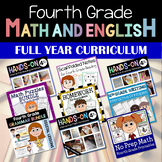Homework for Fourth Grade - 132 Homework Printables | Literacy & Math Review
Yvonne Crawford
5.9k Followers
Grade Levels
3rd - 5th, Homeschool
Subjects
Resource Type
Standards
CCSS4.MD.A.1
CCSS4.MD.A.2
CCSS4.MD.A.3
CCSS4.MD.B.4
CCSS4.MD.C.5a
Formats Included
- PDF
- Internet Activities
Pages
141 pages
Yvonne Crawford
5.9k Followers
Compatible with Digital Devices
The Teacher-Author has indicated that this resource can be used for device-based learning.
Also included in
- Full Year Language Arts Curriculum for Fourth Grade - 2,000 pages - answer keys included!Included:175 pages of grammar and writing interactive printables including answer keys84 Google Slides of the grammar interactive printables for online teaching or distance learningClose ReadingFigurative LanguaPrice $299.53Original Price $599.05Save $299.52
- Full Year Curriculum for Fourth Grade including both language arts and math - 4,000 pages - answer keys included!This bundle contains four interactive notebooks for fourth grade, supplying everything you need to keep students engaged in interactive learning for a whole year of English language artsPrice $705.46Original Price $1410.85Save $705.39
Description
Homework for Fourth Grade includes 120 math and literacy printables that you can give to your students throughout the school year to practice their skills according to the Common Core State Standards for third grade mathematics and English language arts. Each worksheet includes printables for both math and literacy. Also includes 12 writing and drawing prompt printables for extra creative work. Great for distance learning!
The worksheets can be used in the following ways:
- As take-home homework assignments
- As morning work or other in-class assignments
- As an introduction to specific Common Core skills
- As a daily review of Common Core skills learned
- As end-of-year review worksheets
Common Core State Standards covered:
Literacy:
- 4.RL.1
- 4.RL.4
- 4.RF.4
- 4.L.1
- 4.L.2
- 4.L.3
- 4.L.4
- 4.L.5
- 4.L.6
Math:
- 4.OA.1
- 4.OA.2
- 4.OA.3
- 4.OA.4
- 4.OA.5
- 4.NBT.1
- 4.NBT.2
- 4.NBT.3
- 4.NBT.4
- 4.NBT.5
- 4.NBT.6
- 4.NF.1
- 4.NF.2
- 4.NF.3
- 4.NF.4
- 4.NF.5
- 4.NF.6
- 4.NF.7
- 4.MD.1
- 4.MD.2
- 4.MD.3
- 4.MD.4
- 4.MD.5
- 4.MD.6
- 4.MD.7
- 4.G.1
- 4.G.2
- 4.G.3
Find my other homework printables here:
- Homework for Kindergarten
- Homework for First Grade
- Homework for Second Grade
- Homework for Third Grade
- Homework for Fourth Grade
- Homework for Fifth Grade
- Homework for Sixth Grade Math
All artwork is original and created by myself.
Thank you for visiting my store,
Yvonne Crawford
Total Pages
141 pages
Answer Key
Not Included
Teaching Duration
1 Year
Report this resource to TPT
Reported resources will be reviewed by our team. Report this resource to let us know if this resource violates TPT’s content guidelines.
Standards
to see state-specific standards (only available in the US).
CCSS4.MD.A.1
Know relative sizes of measurement units within one system of units including km, m, cm; kg, g; lb, oz.; l, ml; hr, min, sec. Within a single system of measurement, express measurements in a larger unit in terms of a smaller unit. Record measurement equivalents in a two-column table. For example, know that 1 ft is 12 times as long as 1 in. Express the length of a 4 ft snake as 48 in. Generate a conversion table for feet and inches listing the number pairs (1, 12), (2, 24), (3, 36),...
CCSS4.MD.A.2
Use the four operations to solve word problems involving distances, intervals of time, liquid volumes, masses of objects, and money, including problems involving simple fractions or decimals, and problems that require expressing measurements given in a larger unit in terms of a smaller unit. Represent measurement quantities using diagrams such as number line diagrams that feature a measurement scale.
CCSS4.MD.A.3
Apply the area and perimeter formulas for rectangles in real world and mathematical problems. For example, find the width of a rectangular room given the area of the flooring and the length, by viewing the area formula as a multiplication equation with an unknown factor.
CCSS4.MD.B.4
Make a line plot to display a data set of measurements in fractions of a unit (1/2, 1/4, 1/8). Solve problems involving addition and subtraction of fractions by using information presented in line plots. For example, from a line plot find and interpret the difference in length between the longest and shortest specimens in an insect collection.
CCSS4.MD.C.5a
An angle is measured with reference to a circle with its center at the common endpoint of the rays, by considering the fraction of the circular arc between the points where the two rays intersect the circle. An angle that turns through 1/360 of a circle is called a “one-degree angle,” and can be used to measure angles.







